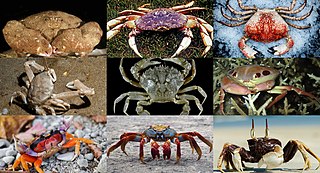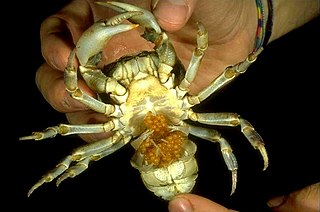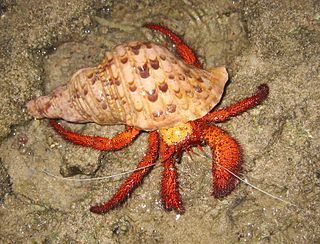Related Research Articles

Crabs are decapod crustaceans of the infraorder Brachyura, which typically have a very short projecting tail-like abdomen, usually hidden entirely under the thorax. They live in all the world's oceans, in freshwater, and on land, are generally covered with a thick exoskeleton, and have a single pair of pincers on each arm. They first appeared during the Jurassic period, around 200 million years ago.

Pleocyemata is a suborder of decapod crustaceans, erected by Martin Burkenroad in 1963. Burkenroad's classification replaced the earlier sub-orders of Natantia and Reptantia with the monophyletic groups Dendrobranchiata (prawns) and Pleocyemata. Pleocyemata contains all the members of the Reptantia, as well as the Stenopodidea, and Caridea, which contains the true shrimp.

Anomura is a group of decapod crustaceans, including hermit crabs and others. Although the names of many anomurans include the word crab, all true crabs are in the sister group to the Anomura, the Brachyura.

Porcelain crabs are decapod crustaceans in the widespread family Porcellanidae, which superficially resemble true crabs. They have flattened bodies as an adaptation for living in rock crevices. They are delicate, readily losing limbs when attacked, and use their large claws for maintaining territories. They first appeared in the Tithonian age of the Late Jurassic epoch, 145–152 million years ago.

Astacidea is an infraorder of decapod crustaceans including lobsters, crayfish, and their close relatives.

Aeger is a genus of fossil prawns. They first occur in the Early Triassic, and died out at the end of the Late Cretaceous. A total of 21 species are known.

Cancer is a genus of marine crabs in the family Cancridae. It includes eight extant species and three extinct species, including familiar crabs of the littoral zone, such as the European edible crab, the Jonah crab and the red rock crab. It is thought to have evolved from related genera in the Pacific Ocean in the Miocene.
Metacarcinus starri is an extinct species of crab in the family Cancridae, subfamily Cancrinae. The species is known solely from the early Miocene, Clallam Formation and the underlying Pysht Formation deposits on the Olympic Peninsula of Washington state, United States.

Dromiacea is a group of crabs, ranked as a section. It contains 240 extant and nearly 300 extinct species. Dromiacea is the most basal grouping of Brachyura crabs, diverging the earliest in the evolutionary history, around the Late Triassic or Early Jurassic. Below is a cladogram showing Dromiacea's placement within Brachyura:

Eocarcinus praecursor is a Jurassic species of decapod crustacean, sufficiently distinct from its relatives to be placed in its own family (Eocarcinidae). Often considered the oldest true crab, it was considered by a 2010 study to be an early member of the Anomura. However, a reanalysis in 2020 again found it to be the earliest known stem-group crab.
Eocarcinoidea is a superfamily of fossil decapod crustaceans. Formerly thought to be the earliest true crabs, they are now thought to be the oldest members of the Anomura. Two species are included, each in its own family-taxon: Eocarcinus praecursor (Eocarcinidae) and Platykotta akaina (Platykottidae).
Glaessneropsoidea is a superfamily of fossil crabs. They are found in rocks from Late Jurassic age to Late Cretaceous. The 45 species in the superfamily are divided among 11 genera in four families:

Cyclida is an extinct order of crab-like fossil arthropods that lived from the Carboniferous to the Jurassic and possibly Cretaceous. Their classification is uncertain, but they are generally interpreted as crustaceans, likely belonging to the superclass Multicrustacea.
Jurellana tithonia, the only species in the genus Jurellana, is a fossil crab. It was found in limestone rocks from the Ernstbrunn Formation in Austria, which have been dated to the Tithonian. It was originally thought to be the world's oldest porcelain crab, but was later determined to actually be a true crab.

Oregonia is a genus of crabs, comprising two extant species and one fossil species: It is classified in the family Oregoniidae under the spider crab superfamily Majoidea.
Tricarina is an extinct genus of crustaceans in order Isopoda, known from a single incomplete fossil specimen from the Cretaceous of western Iran. It has a flattened body with three longitudinal ridges, which give it its name.

Hoploparia is a genus of fossil lobster belonging to the family Nephropidae. The type species of this genus is Hoploparia longimana.
The Cretaceous crab revolution was a major diversification event of brachyuran crabs that took place during the Cretaceous Period, from 145 to 66 million years ago. Nearly 80% of modern groups of crabs originated during this event. The Cretaceous crab revolution is a smaller component of the greater Mesozoic marine revolution.
Tillocheles is an extinct genus of decapod crustaceans that lived during the Cretaceous period. Two species are currently placed in the genus. Fossils of the earlier type species, T. shannonae, have been found in Queensland, while remains of the later species, T. kaoriae, are known from Hokkaido.

Protastacus is an extinct genus of decapod crustaceans that lived in what is now Germany during the early Cretaceous period. The type species is P. politus, and a second species, P. antiquus, is also assigned to the genus. Protastacus grew to around 10 cm (3.9 in) long and had a mostly crayfish-like appearance, with enlarged pincer-bearing appendages and a segmented abdomen. Though formerly assigned to the Astacidae or Nephropoidea, it is currently placed as the only genus in the family Protastacidae, which in turn is the only family in the superfamily Protastacoidea.
References
- 1 2 3 4 Jérôme Chablais, Rodney M. Feldmann & Carrie E. Schweitzer (2011). "A new Triassic decapod, Platykotta akaina, from the Arabian shelf of the northern United Arab Emirates: earliest occurrence of the Anomura" (PDF). Paläontologische Zeitschrift . 85: 93–102. doi:10.1007/s12542-010-0080-y. S2CID 5612385.
- ↑ Rodney M. Feldmann & Carrie E. Schweitzer (2010). "Is Eocarcinus Withers, 1932, a basal brachyuran?". Journal of Crustacean Biology . 30 (2): 241–250. doi: 10.1651/09-3230.1 .